HD420 SL
back to Sennheiser
back to measurements
home
published: Jul-14-2019
NO SMOOTHING is applied to the shown plots. Most measurement sites have some smoothing applied which ‘irons flat’ sharp peaks and ‘wiggles’. I do not use smoothing because some info about sound quality is lost when plots are smoothed.
Aside from a small correction of the microphone itself also some correction in the lowest frequencies is applied to the plots to compensate for the perceived loss of bass when using headphones. This is described HERE in more detail.
A ‘horizontal‘ frequency response curve on the shown frequency response plots on this website thus indicates a perceived ‘flat’ tonal signature.
ALL measurements are made with a good SEAL on a flatbed measurement rig.
The shape of your head, bone structure, pad size, pad ‘softness, (compliance), hair or no hair and or wearing glasses may (drastically) change the frequency response of some headphones, so… your personal experience may differ substantially from these plots.
Frequency response (tonal balance) is the most sound-determining aspect of headphones. A horizontal line shows audible neutral response in the plots on this website. Deviations in different severities at different frequency bands have an effect on the sound character.
The bigger the deviation the stronger the effect.
Below an aid to help determining the sound character of headphones with relation to the frequency response.

Sennheiser HD420 SL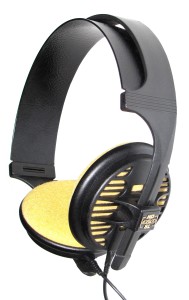
The Sennheiser HD420 SL is an open on-ear dynamic headphone. This is an oldie already and was produced around 1985. It was (converted from currency in that era and not counting inflation) around € 55.- in those days. When taking inflation in mind it would cost € 98.- today.
It was the second cheapest headphone in the line Sennheiser had at that period. The HD430, HD540 reference and HD250-Linear were it’s more expensive brethren. It was preceded by the different looking HD420 (1979). Only the HD410-SL was ‘below’ it
There were two different impedance versions of this headphone. This is the 600Ω version.
Nowadays there aren’t many headphones around in this impedance range but they still exist. The advantage is (was) it can be driver directly from the output of a power amp and one could use lots of them in parallel in studios on one amp without needing a distribution amp. There also was a 50Ω version (HD420 SL-2) which is rarer and had a 3.5mm TRS jack + 6.3mm adapter. The HD420 SL-13 was the 600Ω version but was terminated with a fixed 6.3mm TRS jack.
Strangely enough one could also order drivers in 32Ω but there was no 50Ω replacement driver.
It’s high impedance means it is not a match with portable equipment such as phones/tablets. You need a more ‘serious’ amplifier to make it sing a bit more convincing. Think of headphone amplifiers that can supply a high power output level in 300Ω headphones, OTL tube amps and speaker outputs of integrated amps.
The HD420 SL had a cable with a DIN ‘dice’ connector + a 6.3mm TRS converter.
On the headphone end it has the all familiar Sennheiser 2-pin connector.
Sennheiser is known for supporting their headphones and pads for much older models are still available. Not for this one though. Not a big deal as they are easy to restore.
The headband is made of 1 piece. The construction is very simple yet durable (over 35 years old). It still functions as when new. The headband also has a thinner piece of plastic connected to it that sits on the head. This is wide and together with the small weight (129 gram without the cable) it is quite comfortable.
Despite its sober construction it functions pretty well. The cups can easily swivel and extend far enough and wide enough to fit most if not all heads.
The pads are made of cloth with a plastic mounting ring which also stood the test of time in a glorious way. Only the foam underneath the cloth was totally gummed up and gone.
Comfort is quite high. The pads do get a bit warm on the ears but not sweaty. Clamping force is low yet stays put on the head, also due to its light weight.
specifications:
Type: on ear, open.
Isolation: none
Usage: home and studio
Driver type: dynamic
Pads: cloth covered foam
Foldable: No
Headphone cup connector: 2-pin Sennheiser connector.
Cable entry: dual sided
Cable: 3m cable with DIN ‘dice’ connector + 6.3mm TRS Jack converter
Inner Pad dimensions: diameter = 70mm, thickness 8mm
Driver size: 34mm
Max power rating: 0.1W
Max Input Voltage: 8 Vrms
Max drawn current: 13 mA rms
Max. S.P.L.: 116 dB
Impedance: 600 Ω
Efficiency: 96dB @ 1mW
Sensitivity: 98dB @ 1V
Weight: 129 g.
Clamping force: low
Accessories: 3m cable with 5-pin ‘dice’ DIN connector with 6.3mm TRS jack.
Sound description:
For a 35 year old headphone this HD420 SL still sounds good. I would characterize it as ‘politer’ version of the AKG K501 in sound signature. It is a bit lacking in the lows but is not ‘thin’ sounding. Mids are clear but lack ‘details’ and don’t sound very ‘dynamic’.
A little ‘boring’ would be a correct description but tonally correct in the mids.
Lacking ‘grunt’ and ‘body’ in the lows and lacking ‘sparkle’, ‘finessse’ and ‘air’ in the treble. Of course one has to take into account that this was the cheapest Sennheiser headphone that came out in that period and headphone line.
When you have an amplifier that can supply enough voltage and some extra headroom to spare some EQ in the lows and upper treble improves the sound quality considerable.
Bass is fuller and the lack of sparkle/details is ‘solved’ and the headphone sounds much better. Still lacking in ‘dynamics’ but otherwise impressive for its age.
Measurements:
Below the frequency response of the HD420 SL (Left, Right)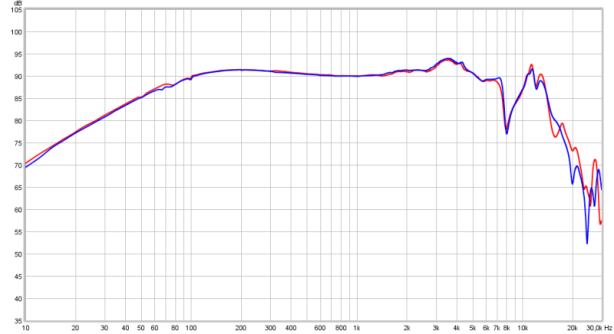 Channel matching is phenomenal. Obviously this wasn’t an issue about 35 years ago… Bass rolls off audible below 100Hz. Mids are well… very ‘flat’ with merely a small 3dB ‘bump’ at 3.5kHz but extending all the way up to 7kHz. There is a small dip at 8kHz followed by a peak at 11kHz. It starts to drop-off above 14kHz.
Channel matching is phenomenal. Obviously this wasn’t an issue about 35 years ago… Bass rolls off audible below 100Hz. Mids are well… very ‘flat’ with merely a small 3dB ‘bump’ at 3.5kHz but extending all the way up to 7kHz. There is a small dip at 8kHz followed by a peak at 11kHz. It starts to drop-off above 14kHz.
Seal
Seal can be an issue with closed-back headphones. Not so much with open headphones and even less so with ‘foam’ pad headphones. Below with a perfect seal and with the headphone lifted about 5mm on one side. because the distance to the driver became bigger one looses bass and a bit of level.
because the distance to the driver became bigger one looses bass and a bit of level.
Normally it would fit fully on one’s ear and maybe have a gap of a few mm tops.
output resistance / damping-factor
As this is a dynamic headphone the frequency response might be amplifier output resistance dependent when certain higher output resistance amplifiers are used.
To test this the headphone is measured via a low impedance amplifier (0.2Ω) and a high impedance amplifier (120Ω). On a higher output resistance amplifier the output level will be lower. To compensate for this the amplifier is cranked up to the same level (at 1kHz, merely 1.6dB in this case) as the low impedance amplifier. This way the plots are overlay-ed and it is easier to see how the tonal balance changes.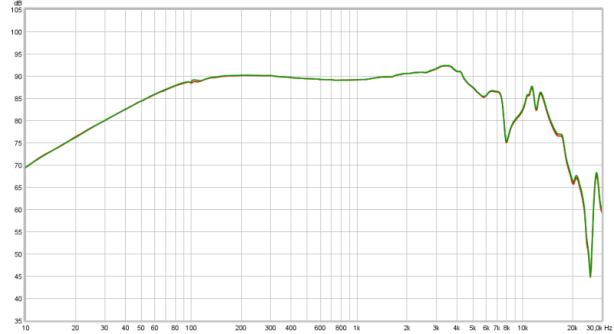 It is quite obvious that this headphone does not react to a higher output resistance at all and it would be perfectly safe to use it from any power amplifier even with a 600Ω output resistance (which was not unusual in those days on the headphone out socket)
It is quite obvious that this headphone does not react to a higher output resistance at all and it would be perfectly safe to use it from any power amplifier even with a 600Ω output resistance (which was not unusual in those days on the headphone out socket)
Below the distortion plot of the HD420 SL: (Left channel shown)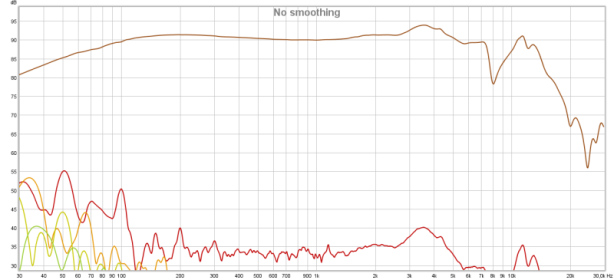
Below the same data but shown in a percentage scale instead of a dB scale.
The 2nd harmonic distortion in the bass area is, not unexpectedly not extremely low and reaches about 3%. The 3rd harmonic distortion (which points to clipping alike behaviour) in the bass area is also reaching 3%. Above 120Hz the distortion is actually very low.
The measurement rig has a relatively high 2nd harmonic distortion so above 200Hz values will most likely even be below 0.1% in reality.
Distortion from 120Hz to 13kHz is quite good.
Below the CSD of the HD420 SL (Left and Right channel are superimposed)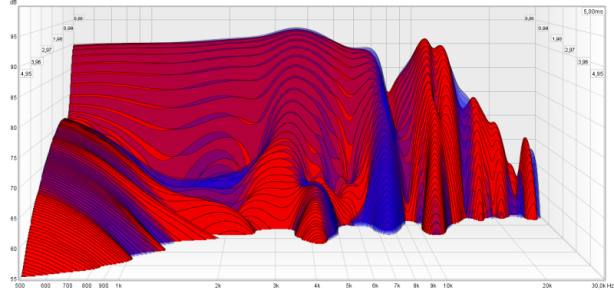 This is quite good performance. A very short lived resonance at around 3.5kHz (the small bump in the FR) and at around 11khz the peak also is a resonance.
This is quite good performance. A very short lived resonance at around 3.5kHz (the small bump in the FR) and at around 11khz the peak also is a resonance.
Combined with the dip this points to a lesser quality treble.
Another form of looking in the time domain is the spectrum plot. The amplitude is color coded and both the time scale and frequency scale differ as well.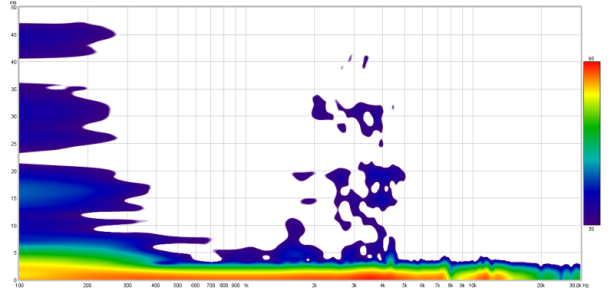 The lows are very well damped and ‘clean’ there is no resonance showing there. The dark blue ‘noise’ in the upper mids is very low level (about 55dB below the signal) so isn’t problematic.
The lows are very well damped and ‘clean’ there is no resonance showing there. The dark blue ‘noise’ in the upper mids is very low level (about 55dB below the signal) so isn’t problematic.
By lack of oscilloscope shots below a step response plot of the HD420 SL (Right, Left)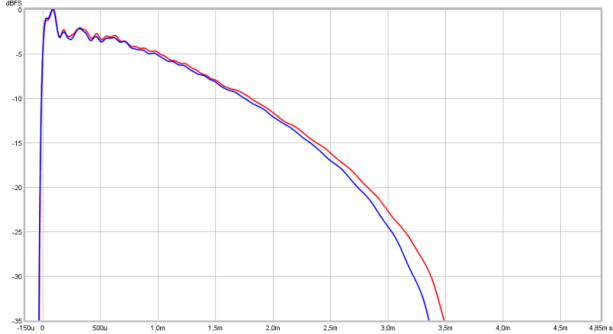 The initial rise is on the correct level and we see an excellent impulse response. Alas the lows roll-off way so soon as the traces should try to stay horizontal as long as possible. Instead they drop off too soon which shows a lack of ‘body’ and ‘grunt’. The headphone sounds clear and ‘midrangy’.
The initial rise is on the correct level and we see an excellent impulse response. Alas the lows roll-off way so soon as the traces should try to stay horizontal as long as possible. Instead they drop off too soon which shows a lack of ‘body’ and ‘grunt’. The headphone sounds clear and ‘midrangy’.
restoring the HD420 SL
As this is an old headphone it really was in need for a little TLC. A restoration was in order. This headphone was well cared for (looked like new) and even came in its original box which even contained a small product folder.
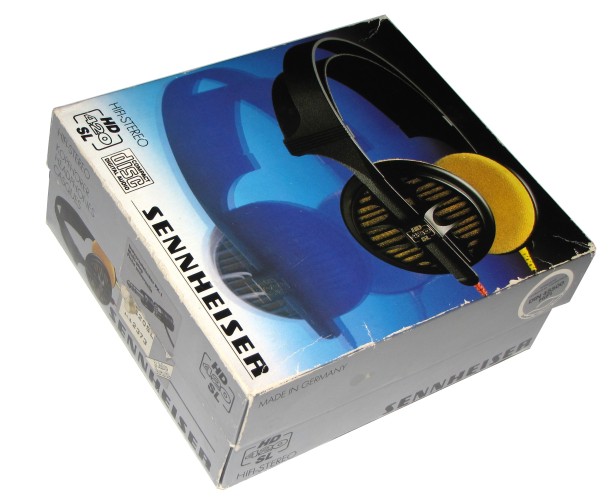 A well known issue is the foam beneath the fabric which has completely decayed. The original pads are no longer available any more but fortunately one can order 80 mm diameter foam pads on e-bay and Chinese websites that have the correct diameter and thickness. These are very easy to install.
A well known issue is the foam beneath the fabric which has completely decayed. The original pads are no longer available any more but fortunately one can order 80 mm diameter foam pads on e-bay and Chinese websites that have the correct diameter and thickness. These are very easy to install.
A bit less known is the fact that behind the driver there also is some foam which also does not function any more and is totally fallen apart/crumpled and gummed up.
This too needs to be replaced.
Remove the cable from the cups and slide the cups off from the headband.
The pads can easily be removed as they are held on by a soft plastic rim around the edge of the cup.
Fortunately the driver and baffle are covered with acoustic paper so the gunk from the foam can easily be removed with an old toothbrush.
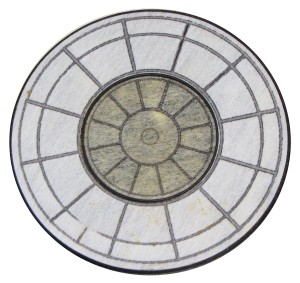
The next step is to ‘pop’ the driver (shown above) out of the cup. It can be pried out quite easily with a small jewelry screwdriver or a utility knife.
Once the driver has popped out you will end up with the driver and the cup.
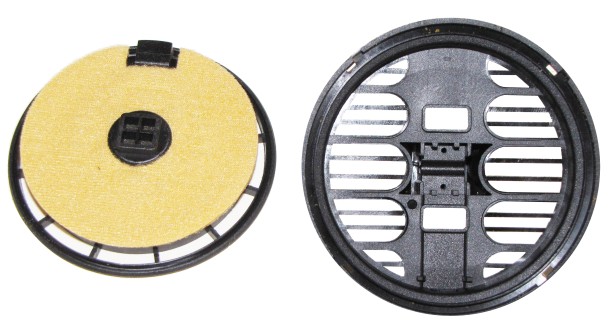
The foam still appears to be in good condition but is totally gummed up and not functioning as intended. With an old toothbrush the gunk can easily be removed.
Below a picture with the decayed foam partly removed.
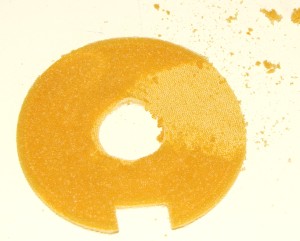
The remaining piece of fabric, together with the cleaned front fabric were handwashed with lukewarm water and mild soap and dried again.
Clean the plastic rear cup.
The piece of fabric above was put on a piece of paper and traced with a pen. That paper was cut out, using pair of scissors, and used as a template to cut out some 3 mm thick foam discs with the same shape as the fabric. For this I used the foam inserts of HD650 pads I had lying around. Below the rear of the driver.
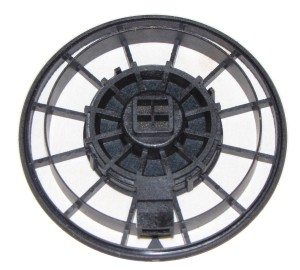
Put the foam shape back on the driver and top it off with the fabric. Click the cup back on. Ensure it is properly alligned so the contacts are accesible.
Put the ordered foam pads (or about 7mm thick foam disc) into the fabric covers and put it back on the drivers carefully.

or alternatively use some foam you may have at hand.
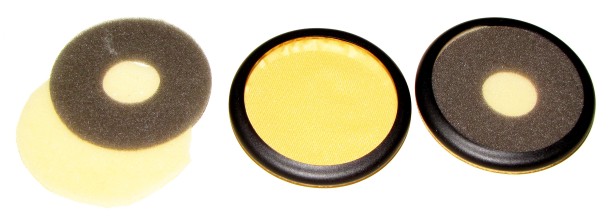
Slide the assemblies back on the headband and connect the wires again.
Observe the L and R markings on the wire. The connectors have 1 thicker pin and 1 slightly thinner pin so they only fit in one direction. The L and R markings on the plugs should point to the outside.
The HD420 SL is now ready once more for many years of usage.
summary
The HD420-SL is a very comfortable headphone with a simple but effective design.
It takes some restoring and a headphone amplifier that can supply some serious output voltages for this headphone to ‘come alive’. It sounds a bit ‘boring’ and lacks ‘body’ and ‘sparkle’ up top with cymbals etc. but with some EQ in the lows and upper treble those negatives disappear.
No, it won’t become a high-end headphone but is still enjoyable this way.
